
Heraldry is a broad term, encompassing the design, display, and study of armorial bearings, as well as related disciplines, such as vexillology, together with the study of ceremony, rank, and pedigree. Armory, the best-known branch of heraldry, concerns the design and transmission of the heraldic achievement. The achievement, or armorial bearings usually includes a coat of arms on a shield, helmet, and crest, together with any accompanying devices, such as supporters, badges, heraldic banners, and mottoes.
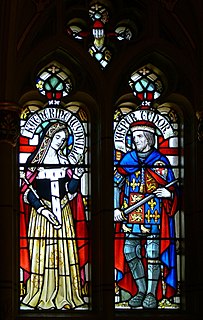
Jasper Tudor, 1st Duke of Bedford, 1st Earl of Pembroke, also called Jasper of Hatfield, was the uncle of King Henry VII of England and a leading architect of his nephew's successful accession to the throne in 1485. He was from the noble Tudor family of Penmynydd in North Wales.

In heraldry, supporters, sometimes referred to as attendants, are figures or objects usually placed on either side of the shield and depicted holding it up.

In heraldry, the field (background) of a shield can be divided into more than one area, or subdivision, of different tinctures, usually following the lines of one of the ordinaries and carrying its name. Shields may be divided this way for differencing or for purposes of marshalling, or simply for style. The lines that divide a shield may not always be straight, and there is a system of terminology for describing patterned lines, which is also shared with the heraldic ordinaries. French heraldry takes a different approach in many cases from the one described in this article.
The lines of partition used to divide and vary fields and charges in heraldry are by default straight, but may have many different shapes. Care must sometimes be taken to distinguish these types of lines from the extremely unusual and non-traditional use of lines as charges, and to distinguish these shapes from actual charges, such as "a mount [or triple mount] in base," or, particularly in German heraldry, different kinds of embattled from castle walls.

In heraldry, variations of the field are any of a number of ways that a field may be covered with a pattern, rather than a flat tincture or a simple division of the field.
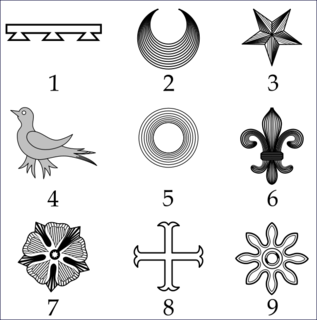
In heraldry, cadency is any systematic way to distinguish arms displayed by descendants of the holder of a coat of arms when those family members have not been granted arms in their own right. Cadency is necessary in heraldic systems in which a given design may be owned by only one person at any time, generally the head of the senior line of a particular family. As an armiger's arms may be used 'by courtesy', either by children or spouses, while they are still living, some form of differencing may be required so as not to confuse them with the original undifferenced or "plain coat" arms. Historically, arms were only heritable by males and therefore cadency marks had no relevance to daughters; in the modern era, Canadian and Irish heraldry include daughters in cadency. These differences are formed by adding to the arms small and inconspicuous marks called brisures, similar to charges but smaller. They are placed on the fess-point, or in-chief in the case of the label. Brisures are generally exempt from the rule of tincture. One of the best examples of usage from the medieval period is shown on the seven Beauchamp cadets in the stained-glass windows of St Mary's Church, Warwick.

In heraldry, an ordinary is a simple geometrical figure, bounded by straight lines and running from side to side or top to bottom of the shield. There are also some geometric charges known as subordinaries, which have been given lesser status by some heraldic writers, though most have been in use as long as the traditional ordinaries. Diminutives of ordinaries and some subordinaries are charges of the same shape, though thinner. Most of the ordinaries are theoretically said to occupy one-third of the shield; but this is rarely observed in practice, except when the ordinary is the only charge.
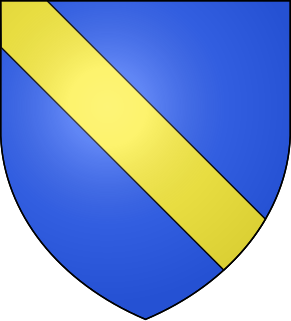
In heraldry, a bend is a band or strap running from the upper dexter corner of the shield to the lower sinister. Authorities differ as to how much of the field it should cover, ranging from one-fifth up to one-third. The supposed rule that a bend should occupy a maximum of one-third of the field appears to exclude the possibility of three bends being shown together, but contrary examples exist. Outside heraldry, the term "bend sinister" is sometimes used to imply illegitimacy, though it is almost never true that a bend sinister has this significance, and a "bar sinister" cannot, by its nature, exist.

In heraldry, a charge is any emblem or device occupying the field of an escutcheon (shield). That may be a geometric design or a symbolic representation of a person, animal, plant, object, building, or other device. In French blazon, the ordinaries are called pièces, and other charges are called meubles.

In heraldic blazon, a chief is a charge on a coat of arms that takes the form of a band running horizontally across the top edge of the shield. Writers disagree in how much of the shield's surface is to be covered by the chief, ranging from one-fourth to one-third. The former is more likely if the chief is uncharged, that is, if it does not have other objects placed on it. If charged, the chief is typically wider to allow room for the objects drawn there.

The coat of arms of Portugal is the main heraldic insignia of Portugal. The present model was officially adopted on 30 June 1911, along with the present model of the Flag of Portugal. It is based on the coat of arms used by the Portuguese Kingdom since the Middle Ages. The coat of arms of Portugal is popularly referred as the Quinas.

The most basic rule of heraldic design is the rule of tincture: metal should not be put on metal, nor colour on colour. This means that or and argent may not be placed on each other; nor may any of the colours be placed on another colour. Heraldic furs as well as "proper" are exempt from the rule of tincture. The rule seems to have operated from the inception of the age of heraldry, i.e. about 1200–1215, but seemingly was never written down. It was rather deduced by later commentators as a rule which must have existed, based on the evidence it produced. Although the vast majority of coats of arms ever used across the whole of Europe follow the rule, a very few coats which contravened the rule were borne in the mediaeval era by certain families or corporate bodies for many centuries without effective censure by the heraldic authorities. The reason for the original contraventions and for the toleration of them is unknown, although in the case of the arms of the Kingdom of Jerusalem clearly extreme high status was involved.

Portuguese heraldry encompasses the modern and historic traditions of heraldry in Portugal and the Portuguese Empire. Portuguese heraldry is part of the larger Iberian tradition of heraldry, one of the major schools of heraldic tradition, and grants coats of arms to individuals, cities, Portuguese colonies, and other institutions. Heraldry has been practiced in Portugal at least since the 11th century, however it only became standardized and popularized in the 16th century, during the reign of King Manuel I of Portugal, who created the first heraldic ordinances in the country. Like in other Iberian heraldic traditions, the use of quartering and augmentations of honor is highly representative of Portuguese heraldry, but unlike in any other Iberian traditions, the use of heraldic crests is highly popular.

In heraldry, a bordure is a band of contrasting tincture forming a border around the edge of a shield, traditionally one-sixth as wide as the shield itself. It is sometimes reckoned as an ordinary and sometimes as a subordinary.
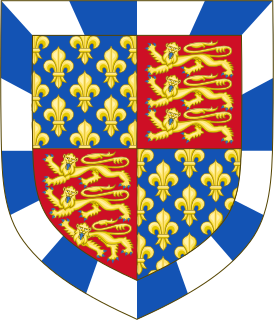
In heraldry, an ordinary componée,, anglicised to compony and gobony, is composed of a row of squares, rectangles or other quadrilaterals, of alternating tinctures, often found as a bordure, most notably in the arms of the English House of Beaufort.

In heraldry and heraldic vexillology, a blazon is a formal description of a coat of arms, flag or similar emblem, from which the reader can reconstruct the appropriate image. The verb to blazon means to create such a description. The visual depiction of a coat of arms or flag has traditionally had considerable latitude in design, but a verbal blazon specifies the essentially distinctive elements. A coat of arms or flag is therefore primarily defined not by a picture but rather by the wording of its blazon. Blazon is also the specialized language in which a blazon is written, and, as a verb, the act of writing such a description. Blazonry is the art, craft or practice of creating a blazon. The language employed in blazonry has its own vocabulary, grammar and syntax, which becomes essential for comprehension when blazoning a complex coat of arms.
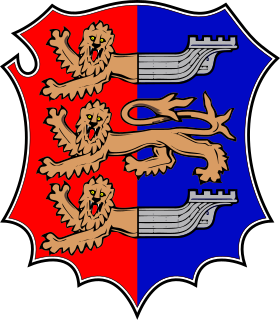
In heraldry, dimidiation is a method of marshalling two coats of arms.

Dexter and sinister are terms used in heraldry to refer to specific locations in an escutcheon bearing a coat of arms, and to the other elements of an achievement. "Dexter" means to the right from the viewpoint of the bearer of the shield, i.e. the bearer's proper right, to the left from that of the viewer. "Sinister" means to the left from the viewpoint of the bearer, the bearer's proper left, to the right from that of the viewer.

Henry Oliver Charles FitzRoy, 12th Duke of Grafton, known as Harry Grafton, is an English peer and music promoter. He inherited the Dukedom of Grafton from his grandfather, Hugh FitzRoy, 11th Duke of Grafton, on 7 April 2011. He is also a direct male-line descendant of Charles II of England.
















